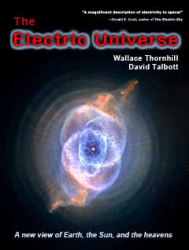|
|
Excerpts From The Electric Universe
Electric Comets Part 3
The following is one of a series of excerpts from The Electric Universe,
copyright © 2002, 2007 Wallace Thornhill and David Talbott and published by
Mikamar Publishing. Reproduced with the kind permission of the authors and publisher.
Presented by Dave Smith
|
|
|
|
February 01, 2010
|
|
|
How is it that a tiny comet nucleus can hold a coma sometimes larger
than the Sun, against the force of the solar wind? If gravity alone were responsible
it would require the nucleus to have a density orders of magnitude higher than any known
substance, yet most comets are said to be low-density bodies. Only the Electric Universe
offers a coherent answer to this paradox.
Page 95
Comets, Electricity and Gravity
Astronomers have calculated the mass and density of comet nuclei
from their presumed gravitational effects on the trajectories of nearby
spacecraft. By this reasoning, comet Halley had a density of only one
tenth to one quarter that of water. But seen in close-up, all comet nuclei
look like solid rock. What is going on?
Science surprisingly takes no account of the electrical nature of
matter when it comes to the related phenomena of inertial mass and
gravity. It is a crucial factor here. Though we intend to take up the
issue of the 'gravitational constant' in a forthcoming monograph, it is
proposed that, if gravity is due to an extremely weak electric
polarization of subatomic particles within charged bodies, gravitational
[p97]
determination of the masses and densities of celestial bodies are
immediately suspect.98
Page 96: INFORMATION PANEL [ Permalink ]
Plasma Discharge Modes
|
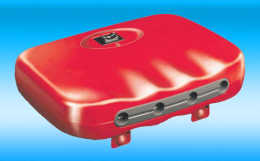
Dark Mode
In 'dark mode,' a plasma discharge in air is detectable
as a breeze. A familiar example is an air ionizer.
Electric discharges occur preferentially from sharp
points so that fine needles are used as discharge
points.
In space, the solar 'wind' constitutes a dark mode
plasma discharge.
|
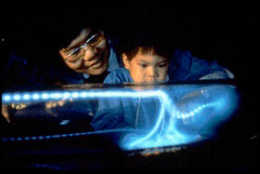
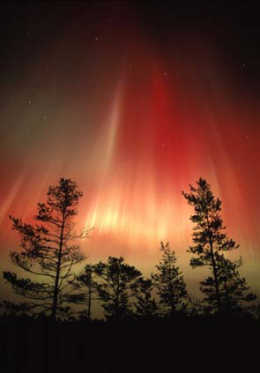
Glow Mode
There are many examples of plasma 'glow mode.'
Above we see the glowing display in a discharge
tube. Indirectly, the fluorescent light makes use of a
glow discharge in the UV part of the spectrum to
cause phosphors coating the inside of the glass tube
to emit visible light. The dancing display of an
aurora and the occasional glow from high-voltage
power transmission lines are examples of plasma
glow discharges.
|
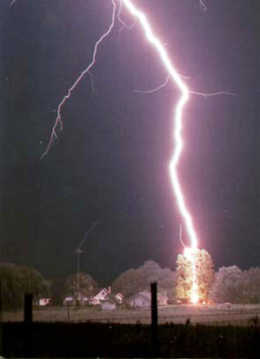
Arc Mode
Lightning is a spectacular form of plasma arc discharge.
Industrial examples are powerful arc lamps
and arc welding.
|
Page 97
We have suggested that the nucleus of a comet can be considered
an electret. An electret is a permanently electrified substance.
If it is separated into pieces, each piece will be electrified.
Due to its small size, the effect of charge polarization within an
electrified comet will be small. We might expect, therefore, that
its gravitationally measured mass will be lower than expected for
the same rocky mass if it were on the Earth's surface. In other
words, if comets look like solid rock they probably are solid
rock. If this model is correct, simple Newtonian calculations of
density and composition that assume G is a universal constant
will be misleading.
|
|
|
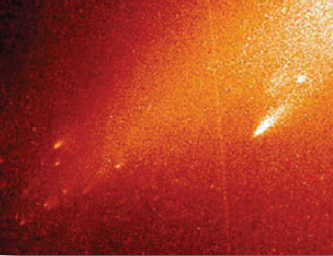
When comet Linear blew apart in the
summer of 2000, the event highlighted
the failure of popular comet
theory to anticipate the actual attributes
and behavior of comets. Linear
was not the 'dirty snowball' of modern
comet lore, and its remains included
little if any water at all.
Credit: NASA, Harold Weaver (the
Johns Hopkins University), and the
HST Comet LINEAR Investigation
Team
[Click to enlarge]
|
|
|
Evidence for electrical stress in comets comes from their
propensity for energetic disintegration, often at large distances from
the Sun where solar heating is minimal. Just as electrical breakdown of
the dielectric material causes a capacitor to explode, electrical
discharges from a comet surface can induce large electric fields within
the subsurface rock, leading to breakdown and explosive
fragmentation of the comet nucleus.
In addition, most large comet nuclei do not exceed one billionth of
the mass of the Earth. How can a piece of rock, no more than a few km
wide, gravitationally hold a ten-million-kilometer-wide bubble against
the force of the solar wind? The entrained envelope is extremely
diffuse, but in gravitational terms it should not be there.
|
|
|
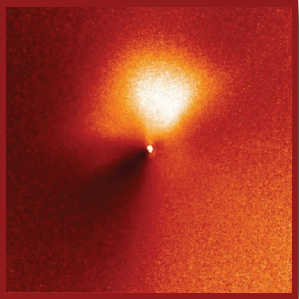
The Hubble Space Telescope
captured this image of a flare
emerging from comet Tempel 1 on
June 14.
Such dusty outbursts are only one of
many features of comets that
astronomers "donít fully understand."
Credit: NASA/HST
[Click to enlarge]
|
|
|
Something stronger than gravity is at work here. If a comet holds
a large negative charge, it will give rise to an immense Langmuir
plasma sheath. This vast envelope is formed and held electrically. A
gravitationally trivial object can be very powerful electrically.
The frequent erratic motions of comets must also be explained.
To account for such motions, which are dubbed 'non-gravitational,'
Whipple looked to the 'jets' seen erupting from the nucleus. As
summarized by Francis Reddy in an obituary the day after Whipple's
death in 2004, the astronomer believed that, “The jets supply a force
that can either speed or slow a comet, depending on the way it rotates
óa force unaccounted for in the astronomical calculations used in
predicting comet returns.”
99 So as comet Linear moved toward
perihelion, a NASA release stated, “Powerful jets of gas vaporized by
[p99]
solar radiation have been pushing the comet to and fro.”
100
Page 98: INFORMATION PANEL [ Permalink ]
Comet Material Born in Fire
|
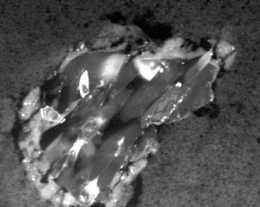 The image on the right shows a comet particle collected by
the Stardust spacecraft. The particle is made up of the silicate
mineral forsterite, also known as peridot in its gem
form. It is surrounded by a thin rim of melted aerogel, the
substance used to collect the comet dust samples. The
particle is about 2 micrometers across.
The image on the right shows a comet particle collected by
the Stardust spacecraft. The particle is made up of the silicate
mineral forsterite, also known as peridot in its gem
form. It is surrounded by a thin rim of melted aerogel, the
substance used to collect the comet dust samples. The
particle is about 2 micrometers across.
NASAís celebrated Stardust mission returned to
Earth the first samples ever of comet dust. On January
2, 2004, the Stardust craft swept past Comet Wild
2, trapping particles as they struck 'aerogel' in a 100-
pound capsule. The capsule parachuted to a Utah
desert on January 15, 2006.
Shockingly, the particles contained minerals that
can only be formed at temperatures of thousands of
degrees. Mineral inclusions ranged from anorthite,
which is made up of calcium, sodium, aluminum and
silicate, to diopside, made of calcium magnesium and
silicate.
How could this be? We have been assured that
comets are the leftovers of a cold 'nebular cloud' that
formed the solar system. This hypothesis has become
an article of faith. Indeed, the implication of a fiery
cometary past was so unexpected that an early
sample of dust was thought to be contamination from
the spacecraft.
“How did materials formed by fire end up on the
outermost reaches of the solar system, where temperatures
are the coldest?” asked Associated Press
writer Pam Easton.
“Thatís a big surprise. People thought comets
would just be cold stuff that formed out ... where
things are very cold,” said NASA curator Michael
Zolensky. “It was kind of a shock to not just find one
but several of these, which implies they are pretty
common in the comet.”
Researchers were forced to conclude that the enigmatic
particle material formed in a superheated region
either close to our Sun, or close to an alien star.
“In the coldest part of the solar system weíve found
samples that formed at extremely high temperatures,”
said Donald Brownlee, Stardustís principal
investigator at the University of Washington in Seattle.
“When these minerals formed they were either
red hot or white hot grains, and yet they were collected
in a comet, the Siberia of the Solar System.”
But comets are supposed to be the 'Rosetta
stones,' constituted primarily of dust and ices, from
which the Sun and planets were formed.
Speculations erupted. Could it be that something
occurred in or very near the Sun in its formative
phase, flinging immense quantities of material out far
beyond the orbit of Pluto, to the 'Oort cloud,' the
legendary and invisible reservoir of comets? But this
would produce a mixing and contradict the zoning
that is evident in the asteroid belt. “If this mixing is
occurring, as suggested by these results, then how do
you preserve any kind of zoning in the solar system,”
Zolenksy asked. “It raises more mysteries.”
Perhaps the story could be rescued by finding the
signature of primordial water whose existence is essential
to the survival of official comet theory.
A report in the journal Nature is illuminating. Phil
Bland, a planetary scientist at Imperial College London
and his team analyzed part of a grain. When he
found large amounts of calcium, Bland was excited.
Could the calcium be present in the form of calcium
carbonate, a mineral that almost always forms in water?
He bet his colleague Matt Genge that this would
indeed be the case.
Bland lost the bet. According to the Nature report
NASA “scientists have not yet found any carbonates
in their grains.”
(See, also,
information panel p. 94.)
|
Page 99
Astronomers applied the same interpretation to the energetic jets
of Borrelly and Wild 2 (pronounced 'Vilt 2'). But in the case of Wild
2, the close-up photographs gave no indication of caverns shaped into
'jet venturis' that could confine the jets to a narrow stream and produce
the measured high jet velocities. And even with velocities up to 1 km/
sec (well above the 0.25 km/sec corresponding to ice subliming into a
vacuum) the jets are too weak to influence the orbit of a comet the size
of a small mountain. However, if the value of the gravitational
'constant,' G, is dependent upon the electrical polarization inside a
comet, strong electrical discharging will change that value. And
changes in G between the Sun and a comet will directly affect the
comet's orbit.
|
|
References:
98
Astrophysicists as a whole have never considered that, if
gravity is a dipolar electric force between distorted subatomic
particles, similar to the 'London force' between electrically
neutral molecules, then the universal 'constant' of gravitation,
G, is actually a variable, dependent on the electrified state
of the body. This disturbing idea is supported not just by the
electrical behavior of comets, but by the fact that G on Earth is
the most elusive physical 'constant' in physics.
99
www.astronomy.com/asy/default.aspx?c=a&id=2429
100
science.nasa.gov/headlines/y2000/ast31jul_1m.htm
|
|
|
|
|
Permalink to this article.
Email this article to a friend
Public comment may be made on this article on the
Thunderbolts Forum/Thunderblogs (free membership required).
To read more from Wal Thornhill please visit:
holoscience.com
|
|
|
|
|
|
|
|
|
YouTube video, first glimpses of Episode Two in the "Symbols of an Alien Sky"
series.
|
|
|
|
|
|
|
Three ebooks in the Universe Electric series are
now available. Consistently
praised for easily understandable text and exquisite graphics.
|
|
|
|
|
|
|
|














